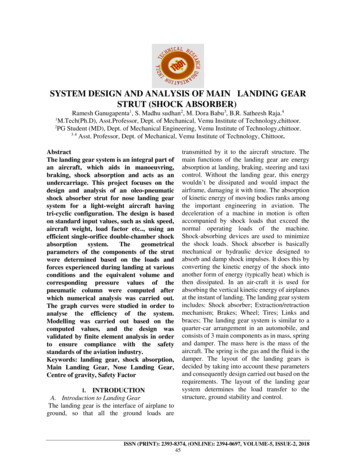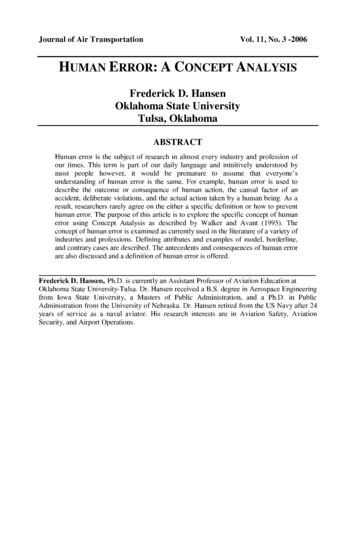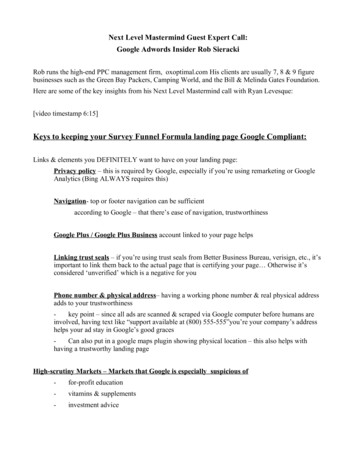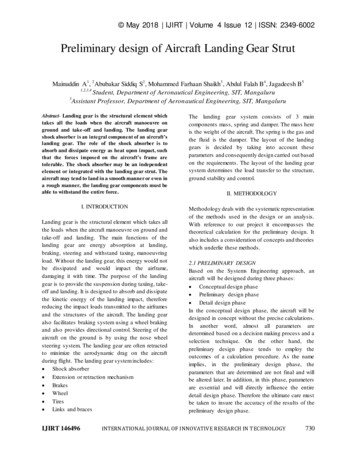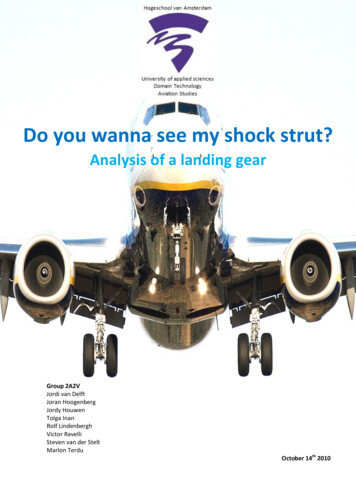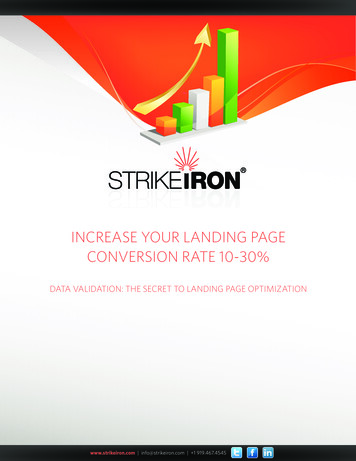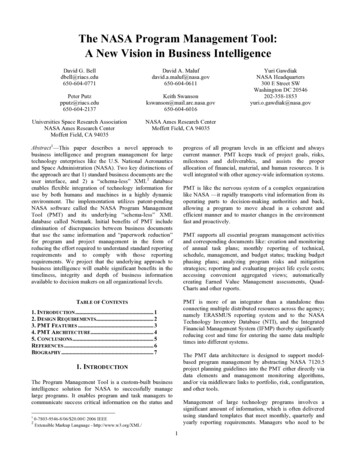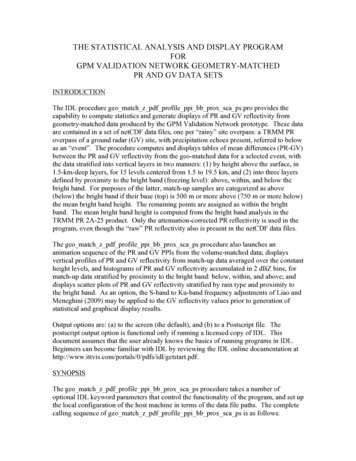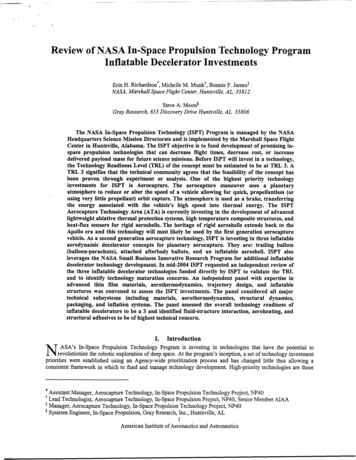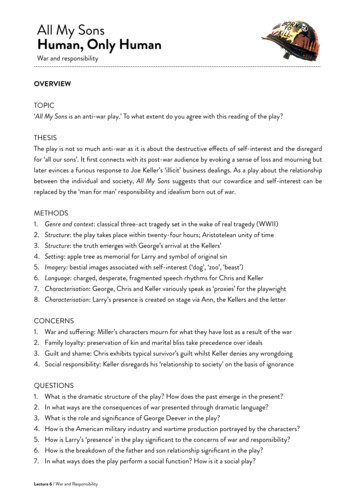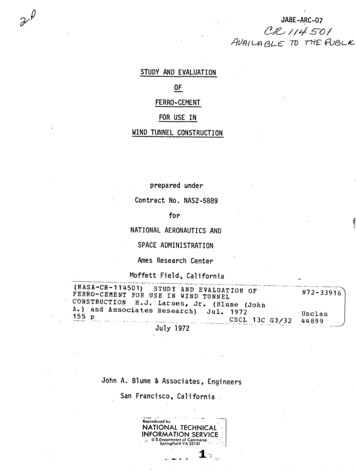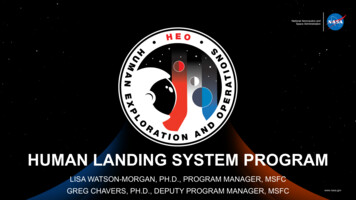
Transcription
National Aeronautics andSpace AdministrationHUMAN LANDING SYSTEM PROGRAMLISA WATSON-MORGAN, PH.D., PROGRAM MANAGER, MSFCGREG CHAVERS, PH.D., DEPUTY PROGRAM MANAGER, MSFCwww.nasa.gov
Overview On April 30, 2020, NASA awarded 3 contracts for the HumanLanding System Broad Agency Announcement Complete lander systems were proposed including launchvehicles for an end-to-end solution for 2024 and sustainingmissions Base Period awards: May 2020-February 2021The Broad Agency Announcement achievedthe innovation from U.S. Industry it was designed to do.5/13/202
579MBASE PERIOD“INTEGRATED LANDER VEHICLE” (ILV) Three-stage landing system— Ascent – Lockheed Martin— Descent – Blue Origin— Transfer – Northrop Grumman (future refueler)— GN&C, Avionics, Software – Draper Rockets: New Glenn & ULA VulcanKEY ATTRIBUTES Significant proven spaceflight heritage Orion and Gateway compatibleAWARD Represents mutually agreed to negotiated fundingto meet company’s specific request3
253MBASE PERIOD“DYNETICS HUMAN LANDING SYSTEM” Single element providing the ascent and descentcapabilities Multiple modular propellant vehicles (MPVs)prepositioned to fuel the engines Large subcontractor team Rockets: ULA VulcanKEY ATTRIBUTES “Mass produced” MPVs Crew cabin sits low to the surface Double-androgynous docking system Orion and Gateway compatibleAWARD Represents mutually agreed to negotiated4funding to meet company’s specific request
135MBASE PERIOD“STARSHIP” Integrated lander Fully reusable launch and landing system Fueling in low-Earth orbit with Starship storageand Starship Tanker variants Rocket: SpaceX Super HeavyKEY ATTRIBUTES Spacious cabin Two airlocks Orion and Gateway compatible; Orion for firstdemoAWARD Represents mutually agreed to negotiatedfunding to meet company’s specific request5
Base Period ActivitiesDuring the 10-month base period, NASA teams will be embedded with the companies tohelp streamline the review of required deliverables to NASA and to impart expertise that theagency has acquired over the last 60 years of human spaceflight systems development. The Base Period CLINs (contract line item numbers) include: CLIN 001 – Base: 2024 HLS Design and Development. 2024 Design and Development, excepting longlead items. CLIN 002 – Base: 2026 HLS Design. Risk-reduction design work in direct support of a potential 2026 HLSperformed during the Base period will be permitted. Note that long lead items necessary to support the 2026mission are not within the scope of this CLIN. (Intended for sustaining) CLIN 003 – Base: Indefinite Delivery/Indefinite Quantity (IDIQ) for 2024 Long Lead Items. For this CLIN,long lead items are defined as flight hardware with a value of over 100,000 required to be procured duringthe Base period to enable a 2024 flight demonstration. Proposed long lead purchases are only allowedbeginning one month after Authority to Proceed (ATP). Each long lead item shall be proposed as a separatesub-CLIN. CLIN 004 – Base: IDIQ - Special Studies. Special studies, analysis, and/or support tasks as initiated bywritten direction from the Contracting Officer.5/13/206
Challenges & RisksBLUE ORIGINDYNETICS Numerous, highly complex launch,rendezvous, and refueling operations inquick succession Proposed launch vehicle maturityPropulsion system developmentcomplexities Complex integrated propulsion systemsdevelopmentDamage to common descent-ascentvehicle from engine induced surfacedebris during landing Crew egress-ingress height above thesurface Proposed launch vehicle maturity Proposed launch vehicle maturity Complex integrated power andpropulsion systems development Complex integrated propulsion systemsdevelopment Propulsion system developmentcomplexities Integrated system checkout after crewarrival 5/13/20SPACEXGovernment collaboration team, including JPL providing additional expertiseCross-Agency NASA subject matter experts providing insight for certificationEffectuate changes through quick turnaround trade studies with the contractor via IDIQsPursuant to reduced risk, IDIQ to the contractor to use only higher TRL technologies for 20247
Potential Trades to Enable 2024 NASA Trade Studies to enable 2024 Assessing TRL of systems Inter-element mechanisms for mating / in-space aggregation of the HLS Extravehicular mobility suit mass reduction effort Orbit best suited for fast abort and optimal stay capability Purpose of Government trades are to improve overall mission success and decreasemission risk5/13/208
Types of Work – Insight Insight: Traditional government review of contractor products leading to certificationof flight readiness Review and approval of required contract deliverables (e.g. Type 1 & 2 Data RequirementsDescription (DRDs)) The primary goal of insight is linked to the certification of flight readiness of the integrated system(including launch vehicle) HLS Program directed tasks intended to understand the contractors’ designs, processes and productsand to ensure the contractor Is following purported processes Insight supports verification, certification, compliance to design/construction standards, cybersecurityrequirements, safety and health & medical requirements/standards Joint Flight Operations including mission planning (Blended Team) Jointly responsible activities with contractor led by Lander Flight Operations Office within JSC’s FlightOperations Directorate (FOD) to assure design meets operational scenarios Flight Operations/Contractor joint activities developing operational products, training and flight control,to include the mission architecting across the Agency Lander Flight Operations NASA team is leading all aspects of the mission when crew dons theintegrated HLS, through landing on the moon and safe return to the Orion5/13/209
Types of Work – Collaboration & Risk Reduction Collaboration: Government experts working alongside the contractor developingproducts Contractor requested Government support in the form of products, expertise orservices Collaboration workforce will execute specific tasks (e.g. design support, analysis,testing) or will provide subject matter expertise to the contractor as directed by theHLS Program Manager Collaboration Workforce allows contractors to leverage NASA extensive expertise andexperience to expedite their human landing systems and focus on crew safety Government provided services and/or products to a contractor via Government TaskAgreements (GTA) Collaboration workforce provide the contractors extra labor to help expedite schedule(up to 50 EP) Advanced Development & Risk Reduction: Government team to work parallel activitiesto aid in quick turnaround risk mitigation informing the program and the contractor fordecision-making HLS Program directed tasks to reduce or mitigate risks for 2024 HLS Program directed and managed tasks to mature systems/subsystems necessaryto support sustained architecture5/13/2010
BACKUP
Goals for First 3 MonthsGoals1. Come toagreement onrequirementsSE&I and TAs withsupport from OfficesContractor ProductsIntegrated LanderSystem SpecificationDRD & others Contractor StandardsProcessesStd Adjudication ProcessD&C, S&MA, H&M2. Understand thecontractor’sconcept andplans & identifyany areas ofconcernAll OfficesSafety DRD ReviewsHCBHLS Control Board Decisions HSERPSERFHCBSERFHCB Concept Feasibility AssessmentDirect engagementMilestone ReviewsOngoing HCB Joint Mission Planning& Flight OperationsRisk IdentificationSERFSERFSERFHRAFHCBAccept or Reject standardsagreementsAccept or Reject ContractorSpecification(inclusive of standards agreements& all other requirements)Provide Contract Direction if necessaryInitiate new HLS program risk &mitigation activities if necessaryHLS Control Board Decisions DRDsHCB HLS Control BoardHSERP HLS Safety Engineering Review PanelDRD Data Review DocumentsTA Technical AuthoritiesSERF Systems Engineering Review ForumHRAF HLS Risk Advisory ForumSE&I Systems Engineering and IntegrationFocusedReview DRD ReviewsProposalDeliverablesOutcomeAccept or Reject Type 1 and 2DeliverablesInitiate new HLS program risk &mitigation activities if necessaryApprove deeper level of insight ifnecessaryProvide Contract Direction if necessaryHLS Offices Concerns not yet ready for board actionswill be held as watch items within an officeHCBIf needed12
Government Furnished EquipmentMandatory ListSystemEVAEVAEVAEVACrew SystemsCrew SystemsCrew SystemsCrew SystemsUtilizationUtilizationEVAEVAEVAEVAEVACrew Health & PerformanceCrew Health & PerformanceCrew Health & PerformanceECLSSGateway/OrionHardwarexEMUxEMU Ancillary EquipmentMounted Interfaces & EquipmentUmbilicalsClothingHygiene SuppliesCrew Personal EffectsOperational SuppliesSample Return EquipmentScience EquipmentxEMU Suits, Stowage Fitcheck Hardware (not flight hardware)xEVA Hardline Comm/Data functional checkoutxEVA SPCE Vehicle Interface V&V UnitxEMU Simulator box (“Flat Suit” blackbox which simulates nominal suit telemetry data to facilitate end-to-end checkout)EVA Handrails (Class III) for vehicle mockupsFoodContingency FoodRadiation DetectionWaste Management SystemGateway/Orion Simulator/Emulator (see SOW 6.4.2)This represents the mandatory GFE that NASA will provide for HLS demonstration missions. Contractorshave the option to request additional GFE such as access to testing facilities.5/13/2013
long lead items are defined as flight hardware with a value of over 100,000 required to be procured during the Base period to enable a 2024 flight demonstration.
